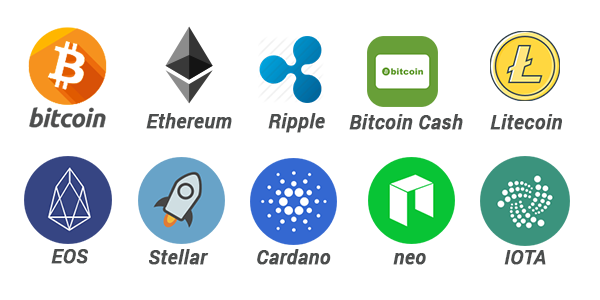
A cryptocurrency, crypto-currency, or crypto is a digital asset designed to figure as a medium of exchange wherein individual coin ownership records is stored during a ledger existing in an exceeding variety of a computerized database using strong cryptography to secure transaction records, to manage the creation of additional coins, and to verify the transfer of coin ownership. Cryptocurrency doesn't exist in physical form (like paper money) and is usually not issued by a central authority. Cryptocurrencies typically use decentralized control against a financial organisation's digital currency (CBDC). When a cryptocurrency is minted or created before issuance or issued by one issuer, it's generally considered centralized. When implemented with decentralized control, each cryptocurrency works through distributed ledger technology, typically a blockchain, that is a public financial transaction database.
It is broadly defined as a virtual or digital money that takes the form of tokens or “coins.”The “crypto” in cryptocurrencies refers to complicated cryptography that allows for the creation and processing of digital currencies and their transactions across decentralized systems.
Bitcoin, first released as open-source software in 2009, is that the first decentralized cryptocurrency. Since the discharge of bitcoin, many other cryptocurrencies are created.

DIFFERENT CRYPTOCURRENCIES
- BITCOIN
Bitcoin (₿) is a decentralized digital currency, without a central bank or single administrator, that can be sent from user to user on the peer-to-peer bitcoin network without the need for intermediaries. Transactions are verified by network nodes through cryptography and recorded in a public distributed ledger called a blockchain. The cryptocurrency was invented in 2008 by an unknown person or group of people using the name Satoshi Nakamoto. The currency began use in 2009 when its implementation was released as open-source software. Bitcoins are created as a reward for a process known as mining. They can be exchanged for other currencies, products, and services, but the real-world value of the coins is extremely volatile. Research produced by the University of Cambridge estimated that in 2017, there were 2.9 to 5.8 million unique users using a cryptocurrency wallet, most of them using bitcoin. Users choose to participate in the digital currency for a number of reasons: ideologies such as commitment to anarchism, decentralization and libertarianism, convenience, using the currency as an investment and pseudonymity of transactions. Increased use has led to a desire among governments for regulation in order to tax, facilitate legal use in trade and for other reasons (such as investigations for money laundering and price manipulation).
2. ETHEREUM(ETH)
Ethereum is a decentralized software platform that enables smart contracts and decentralized applications (dapps) to be built and run without any downtime, fraud, control, or interference from a third party. The goal behind Ethereum is to create a decentralized suite of financial products that anyone in the world can freely access, regardless of nationality, ethnicity, or faith. This aspect makes the implications for those in some countries more compelling, as those without state infrastructure and state identifications can get access to bank accounts, loans, insurance, or a variety of other financial products.Ether, launched in 2015, is currently the second-largest digital currency by market capitalization after Bitcoin, although it lags behind the dominant cryptocurrency by a significant margin. As of January 2021, ether’s market cap is roughly 19% of Bitcoin’s size.
3. LITECOIN(LTH)
Litecoin, launched in 2011, was among the first cryptocurrencies to follow in the footsteps of Bitcoin and has often been referred to as “silver to Bitcoin’s gold.” It was created by Charlie Lee, an MIT graduate and former Google engineer. Litecoin is based on an open-source global payment network that is not controlled by any central authority and uses “scrypt” as a proof of work, which can be decoded with the help of consumer-grade CPUs. Although Litecoin is like Bitcoin in many ways, it has a faster block generation rate and hence offers a faster transaction confirmation time. Other than developers, there are a growing number of merchants that accept Litecoin. As of January 2021, Litecoin has a market capitalization of $10.1 billion and a per-token value of $153.88, making it the sixth-largest cryptocurrency in the world.
4. POLKADOT(DOT)
Polkadot is a unique proof-of-stake cryptocurrency that is aimed at delivering interoperability among other blockchains. Its protocol is designed to connect permissioned and permission-less blockchains, as well as oracles, to allow systems to work together under one roof. Polkadot’s core component is its relay chain that allows the interoperability of varying networks. It also allows for “parachains,” or parallel blockchains with their own native tokens for specific-use cases. Polkadot was created by Gavin Wood, another member of the core founders of the Ethereum project who had differing opinions on the project’s future. As of January 2021, Polkadot has a market capitalization of $11.2 billion and one DOT trades for $12.54.
5. STELLAR(XLM)
Stellar is an open blockchain network designed to provide enterprise solutions by connecting financial institutions for the purpose of large transactions. Huge transactions between banks and investment firms—typically taking several days, involving a number of intermediaries, and costing a good deal of money—can now be done nearly instantaneously with no intermediaries and cost little to nothing for those making the transaction. Stellar was founded by Jed McCaleb, a founding member of Ripple Labs and developer of the Ripple protocol. He eventually left his role with Ripple and went on to cofound the Stellar Development Foundation. Stellar Lumens have a market capitalization of $6.1 billion and are valued at $0.27 as of January 2021.





0 Comments